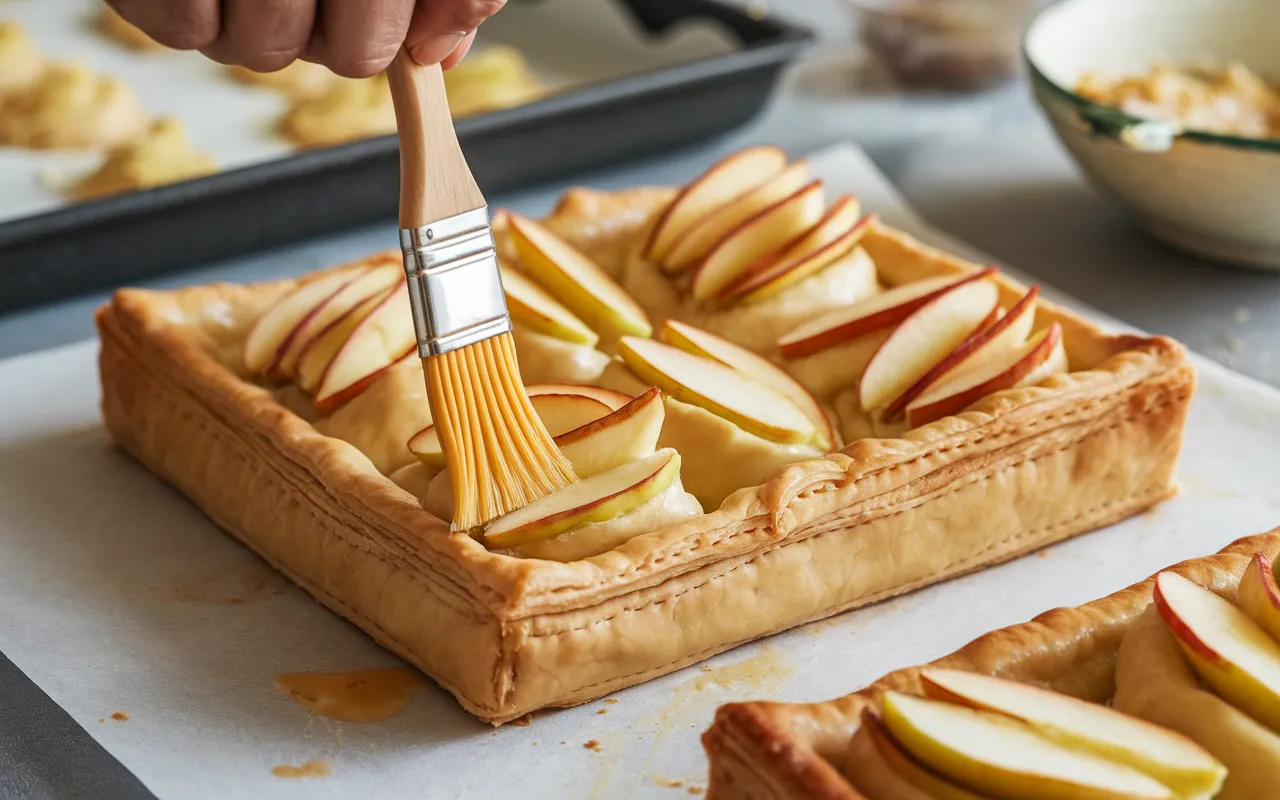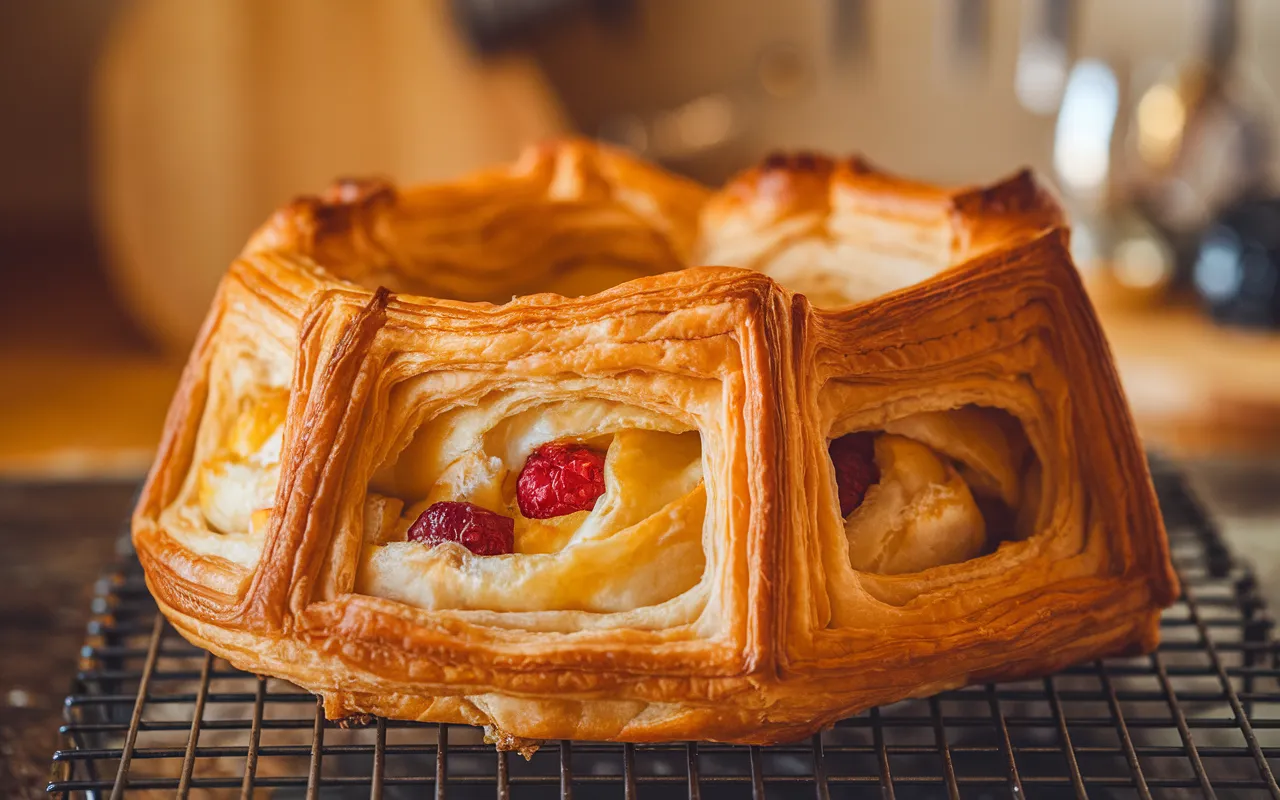Puff pastry is a versatile and beloved ingredient, perfect for both sweet and savory dishes. Yet, one of the trickiest parts of working with this delicate dough is ensuring the filling stays intact during the baking process. This article delves into the art and science of puff pastry fillings, from preparation and handling techniques to baking tips and storage. By the end, you’ll have all the know-how to create flawless puff pastry dishes every time.
Understanding Puff Pastry and Its Fillings
What is Puff Pastry?
Puff pastry, a classic in the world of baking, is a delicate, flaky dough made through a series of folds that create hundreds of thin layers. These layers, which are made by alternating dough and butter, give puff pastry its signature rise and texture. The process of preparing puff pastry, called “lamination,” relies on the expansion of steam trapped between the layers during baking.
Thanks to its neutral flavor, puff pastry is incredibly versatile, serving as the foundation for savory pies, sweet turnovers, tarts, and more. However, its delicate nature makes it essential to handle with care, especially when adding fillings that could potentially break or seep through the layers.
Common Types of Fillings Used in Puff Pastry
From fruity delights to hearty, savory options, puff pastry can house a variety of fillings. Popular choices include:
- Savory Fillings: Creamy cheese blends, spiced meats, sautéed vegetables, and herbed chicken.
- Sweet Fillings: Fruit compotes, chocolate, cream cheese, or nut spreads like almond paste.
It’s crucial to choose fillings with the right texture and consistency. For instance, watery ingredients like fresh fruits without preparation can cause sogginess. Instead, precook or drain such fillings to ensure they remain cohesive and flavorful during baking.
Importance of Proper Filling Techniques
Here’s the kicker: even the best filling can turn into a disaster without the proper techniques. Fillings that are too wet, poorly sealed edges, or overstuffed pastries are common culprits behind leaks and uneven baking. To prevent this, maintaining balance is key—don’t overfill, and ensure the pastry is properly sealed before baking.
By understanding the basics of puff pastry and the role fillings play, you set a strong foundation for baking success. In the next section, we’ll explore how to prepare puff pastry so it’s ready to handle fillings like a pro.
Preparing Puff Pastry for Filling
Thawing and Handling Puff Pastry
Handling puff pastry correctly starts with proper thawing. Since most store-bought puff pastry comes frozen, it’s essential to let it thaw gradually in the refrigerator for 3–4 hours or overnight. Avoid speeding up the process by using heat, as this can compromise the butter layers that are vital for its texture.
When ready to work with, keep the dough cool to the touch but pliable. Overhandling can cause the butter to melt, which disrupts the lamination. Use a light dusting of flour on your work surface to prevent sticking, but don’t go overboard—too much flour can make the dough tough.
Rolling Out Puff Pastry to the Correct Thickness
Getting the right thickness for puff pastry is crucial. Ideally, aim for about 1/8 inch (3 mm) for most recipes. This ensures the dough will puff up beautifully while being strong enough to support the filling.
Roll the dough evenly in all directions, working from the center outward. Avoid pressing too hard; instead, use gentle, steady pressure. A pastry mat with marked measurements can help ensure consistency, especially for recipes that require precise dimensions.
If the pastry feels too soft or sticky at any point, pop it back in the fridge for 10–15 minutes. Working with chilled dough is always easier and prevents the butter layers from blending into the dough.
Cutting Puff Pastry for Different Shapes and Sizes
Depending on the recipe, puff pastry can be cut into squares, rectangles, circles, or custom shapes. Use a sharp knife or pastry cutter to avoid dragging the dough, which could seal the layers and hinder puffing during baking.
- Rectangles or Squares: Ideal for turnovers or layered pastries.
- Circles: Great for tarts or small pies.
- Custom Shapes: Perfect for themed or decorative bakes.
When cutting, make sure your edges are clean and even. Uneven cuts can lead to improper sealing and uneven puffing. With the dough prepped and shaped, you’re ready to focus on filling and sealing, which we’ll cover in the next part.
Techniques to Prevent Filling Leakage
Sealing Edges Effectively
Using Egg Wash as a Sealant
Egg wash isn’t just for giving pastries a golden finish—it’s also an excellent adhesive. Before folding or layering the dough, brush a thin line of egg wash along the edges where the pastry will seal. The combination of egg and water acts as glue, keeping the filling securely tucked inside during baking.
Make sure not to overuse egg wash, though. Excess liquid can seep into the layers and cause them to stick together, reducing puffiness.
Crimping Edges with a Fork
For an extra layer of sealing security, crimp the edges with a fork after applying egg wash. Press down firmly but gently to avoid tearing the dough. This not only reinforces the seal but also adds a decorative touch to your pastry.
When working with thicker fillings, you may need to double crimp or fold the edges inward slightly to prevent leaks. Consistency is key—ensure the crimp is even all the way around.
Avoiding Overfilling
While it’s tempting to stuff puff pastry to the brim, overfilling is a recipe for disaster. Too much filling increases the risk of leaks, especially as the contents expand or release moisture during baking.
- For Savory Fillings: Use 1–2 tablespoons per piece, depending on the size of the pastry.
- For Sweet Fillings: Keep it around 1–1.5 tablespoons, particularly for liquid-based fillings like fruit compotes.
When in doubt, err on the side of less filling. You can always add a decorative dollop or drizzle on top after baking for extra flair.
Venting Puff Pastry to Release Steam
To avoid soggy pastries, venting is critical. Small slits or holes in the dough allow steam to escape, preventing pressure buildup that can cause fillings to burst out.
Use a sharp knife or the tip of a skewer to make 1–2 small incisions on top of the pastry before baking. For intricate designs, use a lattice cutter or cookie cutter to create decorative vents.
By mastering these techniques, you’ll drastically reduce the chances of filling leakage and achieve consistently professional results. Up next, we’ll explore baking considerations that bring it all together.
Baking Considerations
Preheating the Oven to the Right Temperature
The journey to perfectly baked puff pastry begins with a well-preheated oven. Puff pastry thrives in high, consistent heat, which activates the butter layers and generates steam for that iconic rise. For most recipes, the ideal temperature ranges between 375°F to 425°F (190°C to 220°C).
A cold oven can cause uneven baking and result in a dense or greasy texture. So, always give your oven enough time to preheat fully before placing the pastries inside. To ensure accuracy, use an oven thermometer, as many ovens run slightly hotter or colder than the dial indicates.
Positioning Pastries on the Baking Sheet
Arranging pastries on the baking sheet might seem straightforward, but it’s crucial for even cooking. Use a parchment-lined or lightly greased baking sheet to prevent sticking and ensure easy removal after baking.
Space pastries about 1–2 inches apart to allow proper air circulation. Overcrowding the tray can cause uneven puffing and browning. For large, filled pastries, consider chilling the assembled pieces on the tray for 10–15 minutes before baking—this step helps the dough maintain its shape in the oven.
If you’re baking multiple trays, avoid stacking them directly on top of each other. Instead, rotate the trays halfway through the bake for uniform results.
Monitoring Baking Time to Prevent Overcooking
Timing is everything when baking puff pastry. Most puff pastry recipes require 15–25 minutes in the oven, depending on the size and filling. Keep an eye on the pastries during the last few minutes, as overcooking can result in dry, overly crisp layers.
A good indicator of doneness is a golden-brown color on the surface and a puffed structure. If you’re unsure, gently lift a corner of the pastry to check for even browning on the bottom. Avoid opening the oven door repeatedly, as this can cause heat loss and disrupt the baking process.
With these baking practices, your puff pastries will emerge golden, flaky, and filled to perfection. Next, let’s discuss the essential post-baking steps to complete the process.
Post-Baking Tips
Cooling Pastries Properly
Once out of the oven, patience is key. Allow your puff pastries to cool on a wire rack to maintain their crispy texture. Transferring them directly to a solid surface can trap steam underneath, leading to sogginess.
For filled pastries, cooling is especially important to set the filling and make handling easier. Sweet fillings, in particular, can be molten hot right out of the oven, so wait at least 10–15 minutes before serving.
Storing Filled Puff Pastries
To keep your pastries fresh and flavorful, proper storage is essential. If you plan to eat them within a day, store them at room temperature in an airtight container. This helps preserve the crispness of the layers.
For longer storage, refrigerate filled pastries in an airtight container lined with parchment paper to prevent condensation from softening the crust. If you want to enjoy them later, reheat in a 375°F oven for 5–10 minutes to restore their flaky texture.
Avoid freezing pastries with liquid or delicate fillings, as this can alter the texture upon thawing. Savory pastries, however, often freeze well for up to 1–2 months.
By following these post-baking tips, you’ll extend the shelf life of your puff pastry creations without sacrificing quality. Now, let’s move to the FAQs to address some common concerns about puff pastry fillings.
Frequently Asked Questions (FAQs)
How do you prevent puff pastry from becoming soggy with wet fillings?
To avoid sogginess, ensure that your filling is not too wet. For fruit fillings, cook them down to reduce moisture or drain excess liquid. If using vegetables, pre-cook or sauté them to remove water content. Additionally, sprinkle a thin layer of breadcrumbs or grated cheese on the pastry before adding the filling—this acts as a barrier to absorb excess moisture.
What is the best way to seal puff pastry edges?
The best way to seal puff pastry is by using an egg wash—a mix of beaten egg and water or milk. Brush the edges lightly before folding or layering the pastry. For extra security, crimp the edges with a fork or pinch them together firmly. This method ensures the filling stays inside while baking.
Can you prepare filled puff pastry in advance?
Yes, you can assemble puff pastry with its filling in advance and refrigerate it for up to 24 hours before baking. This can help the pastry retain its shape during baking. If you need to prepare it even earlier, you can freeze the unbaked pastries. When ready to bake, no need to thaw—just bake straight from the freezer, adding a few extra minutes to the baking time.
Why does my puff pastry not rise properly?
Improper rising is often due to insufficient oven heat or overworking the dough. Make sure your oven is preheated to the correct temperature (375°F to 425°F). Also, keep the dough cool while handling—if the butter melts into the dough before baking, the pastry won’t rise properly.
How do you keep filled puff pastry crispy after baking?
To maintain crispness, cool pastries on a wire rack to prevent trapped steam. Store them in an airtight container at room temperature if consuming within a day. Reheat in the oven at 375°F for a few minutes before serving to restore the flakiness.
What types of fillings are best for puff pastry?
Fillings with a thick, cohesive consistency work best for puff pastry. Popular options include fruit compotes, cheese blends, spiced meats, and sautéed vegetables. Avoid overly wet or runny fillings, as these can cause the pastry to become soggy or leak during baking.
By addressing these common questions, you’ll feel more confident tackling puff pastry recipes and preventing filling mishaps. With these tips and techniques, your pastries will turn out beautifully every time!


